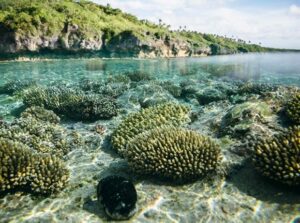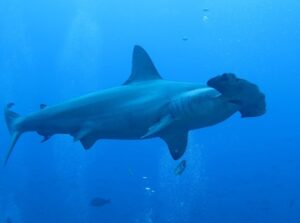A Ray of Hope for Ocean Health
This article was originally published by the Global Environment Facility (GEF) on December 12, 2022.
Blog
The ocean covers 70% of the planet, provides nutrition and income for billions of people, produces most of the air we breathe, and absorbs nearly half of the world’s carbon emissions.
It is also the site of significant international cooperation. Countries are increasingly working together to create marine protected areas, akin to national parks, well beyond their shores.
Marine protected areas have many benefits – they can conserve ecosystems, rebuild fish stocks, and enable scientists to conduct research.
These at-sea refuges have grown in size and number over the past decade, bringing together countries with a shared interest in the health of the ocean and its resources.
Though harder to visit and less visible than their terrestrial counterparts, the fast-growing network of marine protected areas holds great promise for sustaining ocean life, and offers a ray of hope for global efforts to address climate change and pollution threats.
The Global Environment Facility has over the past three decades helped developing countries establish terrestrial protected areas larger than the size of Brazil.
Its 184 member countries are now increasingly focused on building protections at sea as well.
“We are seeing tremendous interest in finding ways to protect the ocean and its resources, and doing so in a collaborative way," said Carlos Manuel Rodriguez, the GEF’s CEO and Chairperson and a former Environment Minister from Costa Rica.
“A generation ago, our focus was on saving land-based ecosystems that were disappearing before our eyes. Today’s tropical rainforests are as healthy as they are because of countries’ efforts to turn priority areas into national parks and protected areas – this was a conscious decision that paid tremendous dividends.
“We are now actively advising and supporting island and coastal countries seeking to build protected spaces offshore. This is an area with tremendous potential for the health of the ocean and we will use every lesson learned from the dozens of marine protected areas we have helped countries establish to date to keep the momentum going."

In 2010, member countries of the Convention of Biological Diversity concluded that at least 10% of coastal and marine areas should be “conserved through effectively and equitably managed, ecologically representative, and well-connected systems of protected areas and other effective area-based conservation measures.”
Four years later, the World Parks Congress called for at least 30% of the ocean to be safeguarded by 2030 – in line with multiple studies confirming that this level of commitment was essential.
And in September 2020, political leaders from 93 countries signed the Leaders’ Pledge for Nature – a commitment to conserving at least 30% of both land and ocean by 2030. Their “30x30” commitment has opened the door to more ambitious coordination on the high seas and a scaling-up of international efforts to prioritize ocean health.
The full membership of the Convention on Biological Diversity will consider the 30% target during its 15th meeting of the Conference of the Parties in December 2022. Negotiations are also underway on a proposed treaty about biodiversity on the high seas, building on GEF-funded efforts to identify vulnerable marine ecosystems in areas beyond national jurisdiction.
At the same time, national and regional efforts to create large marine protected areas are gathering steam.
Hawaii's Papahānaumokuākea Marine National Monument, a 360,000 square km region established in 2006, was expanded to 1,510,000 square km in 2016. The Cook Islands’ Marae Moana Marine Park, created a year later, is even larger, extending over 1,976,000 square km.
The Blue Nature Alliance, a GEF-supported global partnership launched in April 2021, is working to restore a combined ocean area the size of South America by helping countries launch and expand protected zones off every continent. These efforts to protect coral reefs, mangrove and kelp forests, and fish habitats will cover 3.5% of the ocean.
And in January 2022, President Guillermo Lasso of Ecuador announced a massive expansion of protected ocean around the Galapagos Islands, creating a safe pathway to and from Costa Rica’s Cocos Island. The new Hermandad Marine Reserve connected two of the world’s most biologically significant marine habitats.
Immediately afterwards, the leaders of Panama, Colombia, and Costa Rica announced their collective intention to extend and join up their respective marine protected areas to create a giant ocean corridor that will safeguard the migration routes of sea turtles, humpback whales, hammerhead and whale sharks, and other species. In Lasso’s words, they wanted to “tackle together the problems facing our ocean.”

These problems are many. According to the UN’s World Ocean Assessment, more than 80% of the world's fish stocks are now fully or over-exploited, depleted, or recovering from depletion. Dead zones – areas of the ocean with too little oxygen to support marine life – are also proliferating and expanding.
There is growing awareness that no one country can address these challenges alone.
At present only about 8% of the ocean is protected, with less than 3% within “no-take zones” where no extractive activity, including fishing, is allowed. Most of these protected zones are near coasts, with a smaller fraction on the high seas.
There are typically two approaches countries can take when setting up marine protected areas: they can designate strictly regulated sites, or they can establish multi-use regions and carve out smaller protected zones within them.
The limits on human activity within protected areas can also vary. These may include bans on fishing during certain seasons or of certain species. Even limited restrictions have been shown to reverse declines in fish stocks and restore critical habitats such as coral reefs and mangroves which help reduce coastal erosion and storm damage.
Over the past 30 years, the GEF has financed dozens of projects to create and maintain marine protected areas spanning more than 4 million square km – roughly the size of the European Union. This assistance has spanned 23 of the world’s large marine ecosystems, helping 124 countries manage shared marine ecosystems, for instance on the joint stewardship of fish spawning and nursery areas.
A main priority as countries push to expand these efforts is ensuring that new marine protected areas cover the most important areas for the world’s biodiversity.
Another is ensuring that these sites have strong management plans that balance competing demands, and involve those with a stake in their success, including Indigenous Peoples, coastal communities, scientists, fishing operators, and the tourism sector.
Carlos Manuel Rodriguez, an avid surfer who became the GEF’s CEO and Chairperson in June 2020, said that while many people spend limited time in or on the water, the health of the ocean is critical to many aspects of life. He described marine protected areas as a cornerstone of global efforts to address other ocean challenges including over-fishing, plastic pollution, and chemical waste.
“We will all need to be actively involved to protect ocean health for the long term,” he said. “We need to connect the dots between protected areas around the world and change the way we all think about ocean life and its importance.”